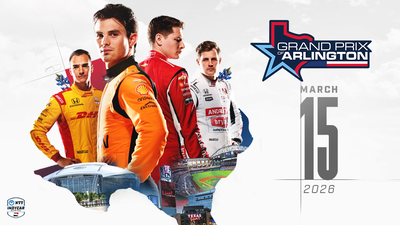Major players get first glance at new Homestead.
Several of the leading IRL IndyCar Series teams got an early taste of the reconfigured Homestead-Miami Speedway last week as the series begins to finalise and tweak the final rules package for the vastly different 1.5-mile Florida oval.
With the relatively flat, one-groove banking now replaced by a variable, progressive banking system starting at 18 degrees in the bottom of the turns and rising to 20 degrees in the outside groove, next season's event will likely see a huge increase in speeds, similar to those seen in the recent NASCAR Winston Cup event at the track.
Several of the leading IRL IndyCar Series teams got an early taste of the reconfigured Homestead-Miami Speedway last week as the series begins to finalise and tweak the final rules package for the vastly different 1.5-mile Florida oval.
With the relatively flat, one-groove banking now replaced by a variable, progressive banking system starting at 18 degrees in the bottom of the turns and rising to 20 degrees in the outside groove, next season's event will likely see a huge increase in speeds, similar to those seen in the recent NASCAR Winston Cup event at the track.
Leading teams Target Chip Ganassi Racing, Marlboro Team Penske, Andretti-Green Racing, Panther Racing and Kelley Racing were all represented, thus ensuring that all competing engine and chassis manufacturers were also present.
Although the IRL chose not to release an official set of lap times, the group who participated in the test, which included 2003 IRL Champ Scott Dixon, rookie of the year Dan Wheldon, Sam Hornish Jr, Helio Castroneves, Scott Sharp and Tomas Scheckter, have been unofficially reported as lapping between the 215-217mph range.
Tony Kanaan won the pole for the 2003 Toyota Indy 300 with an average speed of 203.5mph.
After Dixon won the Toyota Indy 300 on March 2nd, construction crews began rebuilding the four turns, which had been banked at six degrees. NASCAR's season ending 'Ford Championship weekend' gave most people a first glance of the new track and its characteristics with all three competing series (Craftsman Truck, Busch and Winston Cup) showing a dramatic increase in speeds and clear opportunities for two and three wide racing.
The track was repaved, and the SAFER Barrier, which debuted in 2002 at the 86th Indianapolis 500, was installed in the four turns.
Under development by the Indy Racing League and the University of Nebraska Lincoln's Midwest Roadside Safety Facility since 1998, the SAFER Barrier was designed for multiple impacts by IRL IndyCar Series cars and stock cars during an event. NASCAR joined in the development of the project in September 2000.
Brian Barnhart, senior vice president of racing operations for the IRL, supervised the Homestead test.
"This test was conducted so we could evaluate the reconfigured Homestead-Miami Speedway, as it's obviously a lot different from when we last raced there in March." Barnhart said. "Our teams, drivers, manufacturers and league officials gathered valuable data to ensure that the IndyCar Series can put on the best race for the fans, as well as a competitive and safe environment for everyone."
Barnhart said there would be more testing at HMS in December, mainly to allow all competing engine and chassis manufacturers to continue to gather data and to allow tyre supplier Firestone to choose a suitable compound. Unofficial reports suggest that tyre wear was very high on the new surface.
"With all the changes, this is basically a new facility for the IndyCar Series, even though we've raced here since 2001," Barnhart said. "We want to ensure that our teams and drivers, as well as our engine suppliers, Chevrolet, Honda and Toyota, our chassis manufacturers, Dallara and Panoz G Force, and our official tyre, Firestone, have all the data they need to ensure a good and safe show."
The 2004 IRL IndyCar Series season begins at Homestead with the Toyota Indy 300 on February 29th.










